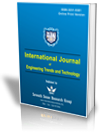AI for Healthcare: Emotional Data Mining for Problem Risk Analysis in University Students on Social Media Using Text Mining Analytics
AI for Healthcare: Emotional Data Mining for Problem Risk Analysis in University Students on Social Media Using Text Mining Analytics |
||
 |
 |
|
| © 2025 by IJETT Journal | ||
| Volume-73 Issue-4 |
||
| Year of Publication : 2025 | ||
| Author : Ploykwan Jedeejit, Wongpanya S. Nuankaew, Patchara Nasa-ngium, Pratya Nuankaew |
||
| DOI : 10.14445/22315381/IJETT-V73I4P135 | ||
How to Cite?
Ploykwan Jedeejit, Wongpanya S. Nuankaew, Patchara Nasa-ngium, Pratya Nuankaew, "AI for Healthcare: Emotional Data Mining for Problem Risk Analysis in University Students on Social Media Using Text Mining Analytics," International Journal of Engineering Trends and Technology, vol. 73, no. 4, pp.432-439, 2025. Crossref, https://doi.org/10.14445/22315381/IJETT-V73I4P135
Abstract
The domain of adolescent mental health care is a critical preventive measure against issues affecting teenagers. Accordingly, the objectives of this research are to analyze the context in which college-educated adolescents encounter mental health challenges through social media, to establish a predictive model reflecting adolescent sentiment in social media postings employing text mining analytics, and to assess the effectiveness of the developed and selected prototype. This research serves as an application of artificial intelligence and text-mining technologies to foster advancements in the prevention and management of adolescent mental health. The data utilized for analysis consisted of 5,230 social media posts from adolescents enrolled at the University of Phayao, addressing six predominant risk factors: alcohol use, infectious diseases, depression, gaming addiction, pregnancy-related issues, and substance abuse. Five distinct machine learning methodologies have been selected for this study: Naïve Bayes (NB), Logistic Regression (LR), Support Vector Machine (SVM), Random Forest (RF), and Decision Tree (DT). The outcomes from the model development and performance testing were notably satisfactory. The models derived using the Support Vector Machine (SVM) and Random Forest (RF) techniques exhibited the highest predictive accuracy, achieving an accuracy rate of 86.81 percent. Consequently, the subsequent research development plan will focus on the practical applications of these findings.
Keywords
Adolescent Problems, AI for Healthcare, Emotional Data Mining, Social Media Addiction, Text Mining Analytics.
References
[1] Yan Wang, “Web Emotion Recognition for College Students Based on Microblog Text Mining,” Proceedings of the 2023 14th International Conference on E-business, Management and Economics, New York, NY, USA, pp. 264-269, 2023.
[CrossRef] [Google Scholar] [Publisher Link]
[2] Xin Chen, Mihaela Vorvoreanu, and Krishna Madhavan, “Mining Social Media Data for Understanding Students’ Learning Experiences,” IEEE Transactions on Learning Technologies, vol. 7, no. 3, pp. 246-259, 2014.
[CrossRef] [Google Scholar] [Publisher Link]
[3] Zuqin Lu, “Analysis Model of College Students’ Mental Health Based on Online Community Topic Mining and Emotion Analysis in Novel Coronavirus Epidemic Situation,” Frontiers in Public Health, vol. 10, pp. 1-15, 2022.
[CrossRef] [Google Scholar] [Publisher Link]
[4] Robin A. Mcgee, David A. Wolfe, and Susan K. Wilson, “Multiple Maltreatment Experiences and Adolescent Behavior Problems: Adolescents’ Perspectives,” Development and Psychopathology, vol. 9, no. 1, pp. 131-149, 1997.
[CrossRef] [Google Scholar] [Publisher Link]
[5] Martina Benvenuti et al., “How Technology Use is Changing Adolescents’ Behaviors and their Social, Physical, and Cognitive Development,” Current Psychology, vol. 42, no. 19, pp. 16466-16469, 2023.
[CrossRef] [Google Scholar] [Publisher Link]
[6] Alison Giovanelli, Elizabeth M. Ozer, and Ronald E. Dahl, “Leveraging Technology to Improve Health in Adolescence: A Developmental Science Perspective,” Journal of Adolescent Health, vol. 67, no. 2 Supplement, pp. S7-S13, 2020.
[CrossRef] [Google Scholar] [Publisher Link]
[7] Joo Eun Lee et al., “Relationship between Mobile Phone Addiction and the Incidence of Poor and Short Sleep among Korean Adolescents: A Longitudinal Study of the Korean Children and Youth Panel Survey,” Journal of Korean Medical Science, vol. 32, no. 7, pp. 1166-1172, 2017.
[CrossRef] [Google Scholar] [Publisher Link]
[8] Mustafa Ozkan, and Betul Solmaz, “Mobile Addiction of Generation Z and its Effects on their Social Lifes: (An Application among University Students in the 18-23 Age Group),” Procedia-Social and Behavioral Sciences, vol. 205, pp. 92-98, 2015.
[CrossRef] [Google Scholar] [Publisher Link]
[9] Christoph Schröer, Felix Kruse, and Jorge Marx Gómez, “A Systematic Literature Review on Applying CRISP-DM Process Model,” Procedia Computer Science, vol. 181, pp. 526-534, 2021.
[CrossRef] [Google Scholar] [Publisher Link]
[10] Rüdiger Wirth, and Jochen Hipp, “CRISP-DM: Towards a Standard Process Model for Data Mining,” Proceedings of the 4th International Conference on the Practical Applications of Knowledge Discovery and Data Mining, Manchester, pp. 29-39, 2000.
[Google Scholar] [Publisher Link]
[11] Jacobus Venter, Alta de Waal, and Cornelius Willers, “Specializing CRISP-DM for Evidence Mining,” Advances in Digital Forensics III, IFIP International Conference on Digital Forensics, National Center for Forensic Science, Orlando Florida, USA, pp. 303-315, 2007.
[CrossRef] [Google Scholar] [Publisher Link]
[12] Devanshi Dhall, Ravinder Kaur, and Mamta Juneja, “Machine Learning: A Review of the Algorithms and Its Applications,” Proceedings of ICRIC 2019: Recent Innovations in Computing, pp. 47-63, 2019.
[CrossRef] [Google Scholar] [Publisher Link]
[13] Jin-Liang Wang, Jia-Rong Sheng, and Hai-Zhen Wang, “The Association between Mobile Game Addiction and Depression, Social Anxiety, and Loneliness,” Frontiers in Public Health, vol. 7, pp. 1-6, 2019.
[CrossRef] [Google Scholar] [Publisher Link]
[14] Dalia El-Sayed Desouky, and Hany Abu-Zaid, “Mobile Phone Use Pattern and Addiction in Relation to Depression and Anxiety,” East Mediterr Health Journal, vol. 26, no. 6, pp. 692-699, 2020.
[CrossRef] [Google Scholar] [Publisher Link]
[15] Elizabeth M. Glowacki, Gary B. Wilcox, and Joseph B. Glowacki, “Identifying #Addiction Concerns on Twitter during the COVID-19 Pandemic: A Text Mining Analysis,” Substance Use and Addiction Journal, vol. 42, no. 1, pp. 39-46, 2021.
[CrossRef] [Google Scholar] [Publisher Link]
[16] Chi-Shin Wu et al., “Using Text Mining to Extract Depressive Symptoms and to Validate the Diagnosis of Major Depressive Disorder from Electronic Health Records,” Journal of Affective Disorders, vol. 260, pp. 617-623, 2020.
[CrossRef] [Google Scholar] [Publisher Link]
[17] Shi-Heng Wang et al., “Text Mining for Identifying Topics in the Literatures About Adolescent Substance Use and Depression,” BMC Public Health, vol. 16, no. 1, pp. 1-8, 2016.
[CrossRef] [Google Scholar] [Publisher Link]
[18] Abdullah J. Sultan, “Addiction to Mobile Text Messaging Applications Is Nothing To ‘Lol’ About,” The Social Science Journal, vol. 51, no. 1, pp. 57-69, 2014.
[CrossRef] [Google Scholars] [Publisher Link]

